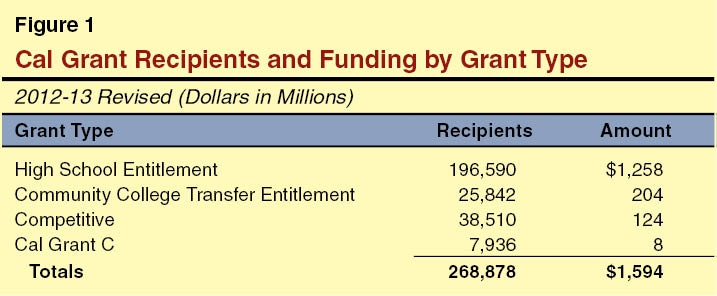2013
Other Budget Issues
| Last Updated: | 3/15/2013 |
| Budget Issue: | Cal Grant funding. |
| Program: | Cal Grants |
| Finding or Recommendation: | Recommend adopting Governor’s January budget proposal to increase total Cal Grant funding by $61 million in 2012-13 and an additional $100 million in 2013-14. The proposed increases are needed to fully fund Cal Grants under current state law. |
Further Detail
Background
Cal Grants Provide Students With Financial Aid to Help With College Costs. The state’s Cal Grant program guarantees financial aid awards to recent high school graduates and community college transfer students who meet financial, academic, and other eligibility criteria. The program also provides a relatively small number of competitive grants to students who do not qualify for entitlement awards. Cal Grants cover full systemwide tuition at the public universities for up to four years and partly contribute to tuition costs at nonpublic institutions. Apart from tuition grants, some students qualify for grants that cover a portion of their living costs. Figure 1 summarizes the number of recipients and funding amounts by grant type in 2012-13.

Governor’s Proposal
The Cal Grant program currently is supported by federal Temporary Assistance for Needy Families funds, the state General Fund, and the Student Loan Operating Fund. The Governor proposes to increase total Cal Grant spending by $61 million in 2012-13 and an additional $100 million in 2013-14 to accommodate increases in the number of students eligible for Cal Grant entitlement awards. Figure 2 shows funding by source for the 2012-13 Budget Act, revised current year and budget year.

Assessment
Current-Year Growth Related to Increased Participation. The number of students applying for and claiming Cal Grants in the current year is about 5 percent higher than projected in the 2012-13 Budget Act. Because entitlement awards are guaranteed to eligible students, costs rise with participation. The administration’s proposal to add $61 million in the current year would align funding with expected award payments.
Two Major Drivers of Budget-Year Growth. Additional growth in Cal Grant costs for 2013-14 is primarily driven by two factors.
- Continuation Costs for 2012-13 Participation Increases. Higher current-year participation results in further cost increases in the budget year. This is because some students who are eligible for only a stipend toward living expenses in their first year of college (a maximum of $1,473) may become eligible for both living expenses and tuition support (up to $12,192 at the University of California) beginning in their second year. The tuition grants add more than $95 million in expected Cal Grant payments in 2013-14. These new costs are offset by more than $15 million in savings due to 2013-14 award reductions enacted last year for students at private institutions. (A reduction in the maximum award from $9,223 to $9,084 for students attending nonprofit institutions and those for-profit institutions accredited by the Western Association of Schools and Colleges is expected to save about $1 million. A reduction from $9,223 to $4,000 in the maximum award for students attending other for-profit institutions is expected to save nearly $15 million.)
- Dream Act Implementation. In addition, the administration projects participation increases in the budget year due to initial implementation of the California Dream Act, Chapter 604, Statutes of 2011 (AB 131, Cedillo). The Dream Act allows certain previously ineligible students to receive Cal Grants beginning in 2013-14. The Governor’s budget includes $19.5 million for an estimated 6,000 newly eligible students.
LAO Recommendation
Recommend Adopting Proposed Cal Grant Funding Increases.Because the proposed augmentations fund increased entitlement costs that the Legislature and Governor already have approved, we recommend adopting the Governor’s proposal.